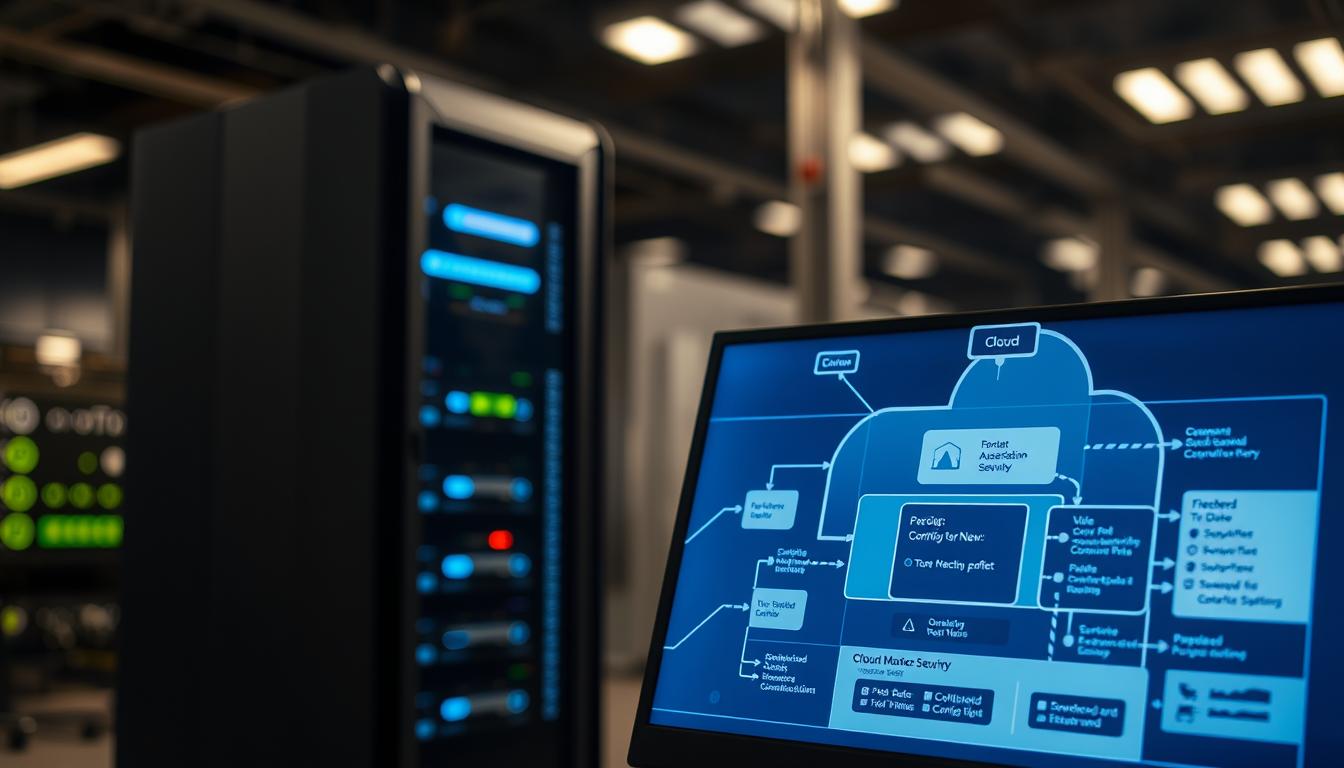In the realm of cloud server security, the configuration of firewalls stands as a pivotal step. It is imperative to safeguard your cloud servers against potential threats, and the setup of firewalls is fundamental to this endeavor. This comprehensive guide will navigate you through the intricacies of configuring firewalls for your cloud servers, equipping you with the requisite knowledge to execute this task proficiently.
Through adherence to this guide, you will acquire the expertise to configure firewalls for your cloud servers, thereby bolstering the security of your cloud-based infrastructure. The process of configuring firewalls is remarkably straightforward, and with this guide, even those with limited experience in cloud server security and firewall configuration will find it accessible. This guide is meticulously crafted to offer a lucid understanding of firewall configuration, ensuring a seamless execution of the steps outlined in this cloud servers step-by-step guide.
Understanding Firewalls and Their Importance for Cloud Servers
In the realm of cloud server security, the comprehension of firewalls is paramount. A firewall constitutes a network security apparatus, tasked with scrutinizing and regulating incoming and outgoing network traffic according to pre-established security protocols. This function is indispensable for cloud servers, serving as a bulwark against unauthorized access, malicious assaults, and other security imperatives. Grasping the mechanics and significance of firewalls enables a deeper appreciation for the necessity of a meticulously configured firewall for your cloud servers.
Firewalls occupy a pivotal position in cloud server security. They act as a deterrent against unauthorized access to your cloud servers, safeguarding your data and applications from nefarious attacks. The initial step towards configuring a firewall involves understanding its operation and the critical role it plays in safeguarding your cloud servers.
- Firewalls help protect against unauthorized access and malicious attacks
- They are vital for cloud server security, as they monitor and control incoming and outgoing network traffic
- Understanding how firewalls work and their importance is crucial for configuring one
Reflecting on these considerations illuminates the imperative of a correctly configured firewall for your cloud servers. It underscores the necessity of robust and effective cloud server security measures.
Types of Firewalls Available for Cloud Servers
In the realm of cloud server security, the selection of an appropriate firewall is paramount. The array of options encompasses software firewalls, hardware firewalls, and next-generation firewalls. Each variant possesses distinct attributes and advantages, necessitating a thorough comprehension of these differences to facilitate an informed decision-making process.
Below is a delineation of the salient features of each firewall category:
- Software firewalls operate as programs on your cloud server, dictating the flow of incoming and outgoing traffic through the application of pre-defined security protocols.
- Hardware firewalls, conversely, are physical entities positioned between your cloud server and the internet, thereby augmenting security with an additional layer.
- Next-generation firewalls, distinguished by their advanced security functionalities, incorporate deep packet inspection and intrusion prevention to safeguard against sophisticated threats.
Given the diversity of firewalls available, the selection should align with the specific security requirements of your cloud server. Whether you prefer a software firewall, a hardware firewall, or a next-generation firewall, the imperative is to choose a solution that offers the requisite level of protection for your cloud-based infrastructure.

Moreover, the consideration of specific security features is crucial. This encompasses functionalities such as intrusion detection, malware protection, and denial-of-service protection. Opting for a firewall that caters to your specific security requirements is essential to safeguard the integrity and availability of your cloud-based data and applications.
Assessing Your Security Needs
In the realm of cloud server security, assessing security needs emerges as a pivotal step. This endeavor necessitates a deep comprehension of the potential risks and threats to your server, alongside an evaluation of your current cloud architecture. Such an approach enables the identification of vulnerabilities, facilitating proactive measures to safeguard your data and applications.
Initially, consider the array of threats your cloud server might encounter. These could encompass hacking attempts, malware, and denial-of-service attacks. Identifying threats is paramount in determining the requisite security level. Additionally, scrutinizing your cloud architecture is imperative to grasp the server’s configuration and potential vulnerabilities.
Several critical factors must be considered when evaluating cloud architecture:
- Network configuration and segmentation
- Data storage and encryption
- Access controls and authentication
Through meticulous assessment of security needs and cloud architecture evaluation, a robust security strategy can be formulated. This strategy aims to fortify your cloud server against potential threats. It may involve the deployment of firewalls, intrusion detection systems, and other security measures to protect your data and applications.
Steps to Configure Firewalls for Cloud Servers
Initiating the process of configuring firewalls is paramount in fortifying your cloud server’s defenses. The first step involves accessing the firewall settings provided by your cloud provider, typically through their control panel. Here, you will delineate security protocols that dictate the flow of traffic, ensuring only authorized access. This phase is critical for safeguarding your cloud server against potential threats.
In the realm of defining security rules, precise specifications are required. You must outline the source and destination IP addresses, ports, and protocols. This necessitates the creation of a list that delineates what traffic is permissible or prohibited. For instance:
- Allow incoming traffic on port 80 for HTTP requests
- Block outgoing traffic on port 25 to prevent spam emails
Post-definition of security rules, thorough testing of the firewall configuration is imperative. This involves verifying that your cloud server remains accessible while ensuring that all necessary traffic is appropriately managed. Adherence to these steps guarantees the security and protection of your cloud server against potential threats. 
Through the configuration of firewalls and the subsequent access to firewall settings, you can establish and test security protocols. This meticulous process is indispensable for safeguarding your cloud server against threats and maintaining the integrity of your data.
Best Practices for Firewall Configuration
Post-configuration, adherence to best practices is paramount to uphold the security of your cloud server. This necessitates the periodic revision of firewall rules to align with architectural evolutions or to counteract emergent security threats. Such practices are instrumental in fortifying your cloud server’s security posture.
The integration of logging and monitoring mechanisms is indispensable, facilitating the surveillance of network traffic and the detection of potential security vulnerabilities. Key aspects of this include:
- Optimization of log collection and storage to guarantee comprehensive data retention
- Activation of alert systems and notifications to promptly signal security breaches
- Periodic log analysis to discern security-related trends and patterns
Adherence to these best practices, encompassing firewall rule updates and logging and monitoring implementation, is vital for safeguarding your cloud server against potential threats.
Supplementary measures for firewall security maintenance include:
- Consistent review and update of firewall rules to maintain efficacy
- Adoption of best practices in logging and monitoring to uncover security risks
- Continual vigilance regarding the latest security trends and threats to ensure firewall efficacy
Common Misconfigurations to Avoid
In the realm of firewall configuration, it is imperative to recognize prevalent misconfigurations that can undermine the security of your cloud server. Common misconfigurations often result in unauthorized access, data breaches, and other security breaches. To circumvent these pitfalls, a thorough understanding of proper firewall configuration is paramount.
One critical error to circumvent is the creation of overly permissive rules that facilitate unauthorized access to your cloud server. Such rules can be leveraged by malicious actors, jeopardizing your data and applications. Additionally, inadequate logging can hinder the detection and mitigation of security incidents.
Common misconfigurations to be vigilant about include:
- Permitting incoming traffic from unverified sources
- Ignoring the necessity to restrict outgoing traffic to only required destinations
- Disregarding the importance of regular firewall log monitoring
By acknowledging these common misconfigurations, you can proactively prevent them and ensure your firewall operates securely. This entails a continuous review and refinement of your firewall rules, the implementation of logging and monitoring mechanisms, and a commitment to staying abreast of emerging security threats.
Tools and Resources for Firewall Management
Efficient management of your firewall necessitates the utilization of specialized tools and resources. A plethora of firewall management tools are available, designed to streamline the configuration, monitoring, and updation of firewall rules. These tools, including management software, significantly simplify the process of safeguarding your cloud server, thereby enhancing its security posture.
Extensive online resources exist, offering invaluable guidance on the configuration and management of firewalls. These resources facilitate the optimization of firewall management tasks, ensuring you remain abreast of the latest security advancements. By integrating these tools and resources into your workflow, you can substantially bolster the security of your cloud server.
The adoption of firewall management software yields several critical benefits:
- Enhanced security, coupled with a diminished risk of breaches
- Streamlined management and configuration of firewall rules
- Augmented monitoring and logging functionalities
- Access to online resources and comprehensive documentation for troubleshooting and support
By leveraging these tools and resources, you can guarantee that your cloud server is safeguarded by a robust, meticulously managed firewall. This not only affords you peace of mind but also protects your invaluable data from potential threats.
Maintaining Your Cloud Server Firewall
The perpetual task of safeguarding your cloud server’s integrity necessitates a vigilant approach. Conducting audits of your firewall settings with regularity is imperative to uphold its efficacy against the proliferation of threats. This diligence ensures that your firewall’s configurations remain aligned with the latest security standards, thereby fortifying your server’s defenses.
Moreover, it is paramount to stay abreast of the most recent security advancements and updates. The advent of novel vulnerabilities and attack methodologies demands a firewall that is equally dynamic in its protective capabilities. By actively engaging with security news and adhering to best practices, your cloud server’s security posture can be sustained at optimal levels.
Ensuring the longevity and efficacy of your cloud server’s firewall necessitates a steadfast dedication to ongoing enhancement. Through the consistent practice of audits and the pursuit of knowledge on the latest security innovations, you can uphold a secure and dependable environment for your vital applications and data.
